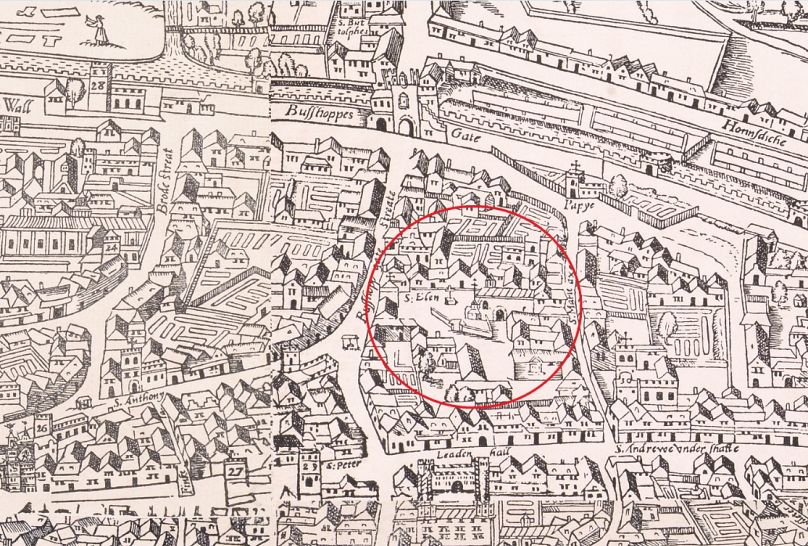The Bard "was living in one of the wealthiest parishes in the City, alongside powerful public figures, wealthy international merchants, society doctors and expert musicians."
Everyone knows that William Shakespeare lived in London. But where exactly? It has never been established for sure -- at least not until the historian Geoffrey Marsh made a discovery that not only pinpoints the Bard's probable address but explains where he drew some inspiration for his plays.
It was previously known that Shakespeare had lived in the St Helen's parish in the City of London, near what is now Liverpool Street Station: he was listed there as a taxpayer in 1597 and 1598, but his precise address was not written down.
But now, thanks to Marsh, we know: the Bard lived at what is now 35 Great St Helens in London -- where musicians and doctors were his neighbours and probable friends, leading to their knowledge having an influence on his work.
There, Marsh found, the Bard lived in the period during which he wrote some of his most famous plays, from Romeo and Juliet to A Midsummer Night's Dream.
Marsh, who works as the Director of the Victoria and Albert (V&A) museum's Department of Theatre and Performance, started working on identifying the exact place where Shakespeare lived since the foundations of 'The Theatre', the playwright's workplace before the Globe Theatre, were excavated in 2008 in Shoreditch. "I have been reconstructing who lived in the parish," Marsh told Euronews.
The key to the mystery was kept by the Company of Leathersellers, a leather trade guild which bought part of the St Helens nunnery in 1543. It still exists today and has preserved records of the company's tenants dating back to the 1550s. Their archives, Marsh realised, could hold unpublished information about Shakespeare's life in the parish.
Two names, which in the parish tax records were listed right above Shakespeare's, appeared in the Leathersellers' tenants list in 1598: John Prymme/Pryn and John Robinson the Younger.
Marsh realised that people were listed in order of their home address, which led to his discovery that Shakespeare must have rented or sub-let rooms in the same properties as Prymme and Robinson, who lived near the churchyard at St Helens.
“The place where Shakespeare lived in London gives us a more profound understanding of the inspirations for his work and life", Marsh explained. "He was living in one of the wealthiest parishes in the City, alongside powerful public figures, wealthy international merchants, society doctors and expert musicians."
Two doctors, Edward Jorden and Peter Turner, were Shakespeare's close neighbours in the parish. Although it cannot be proven that the three knew each other, their close proximity, similar social class and the obligation to attend church in one's parish at the time makes it almost certain they met.
Jorden, Marsh told Euronews, was the first English doctor to specialise in female health. "He was a really progressive doctor, studied what the female character was like", he said, adding that such knowledge might have served Shakespeare, whose female characters are "very well crafted", unlike most other theatre works of the time.
Jorden's expertise led him to be called as an expert witness in witch trials, which often relied on fake notions of female health confused with magic. Could such an experience have enlightened Shakespeare, for example for the three witches of Macbeth...?
Another neighbour of the Bard's, doctor Peter Turner, probably provided Shakespeare with treasures of information in the form of his great collection of rare books, inherited from his father William Turner, a physician who wrote the earliest book on flora in English. Peter had studied at Heidelberg University in Germany (echoes of Hamlet's University of Wittenberg...) and had lived in Padua, Italy, (where Benedick from Much Ado About Nothing hails from_)_ a city which at the time was part of the Venice Empire, Marsh said.
His tales of the Italian cities may have inspired the setting for The Merchant of Venice, and indeed Romeo and Juliet in nearby Verona.
"Shakespeare knew nothing about Italy, but he had lived close to someone who had lived there for years!" Marsh told Euronews.
Shakespearean directors often re-invent these 16th and 17th century masterpieces by giving them a contemporary setting to demonstrate how the way Shakespeare presented the human condition is still just as relevant today. Many will agree that directors are spoilt for choice in Europe right now. Certainly one of the early plays, The Comedy of Errors, where Sicilian migrants are banned from the shores of Turkey, will resonate with the modern European.
Indeed, many of Shakespeare's plays were set in Europe.
Michael Russell, Warden of the Leathersellers, added in a press release: “We are delighted that this information has come to light. The Company has carefully maintained its St. Helens properties for 476 years to help fund our charities. Our company livery hall, was recently rebuilt on the original site acquired in 1543. We always remember that Shakespeare’s father was a glover in Stratford-upon-Avon and would have spent his life working with leather.”













